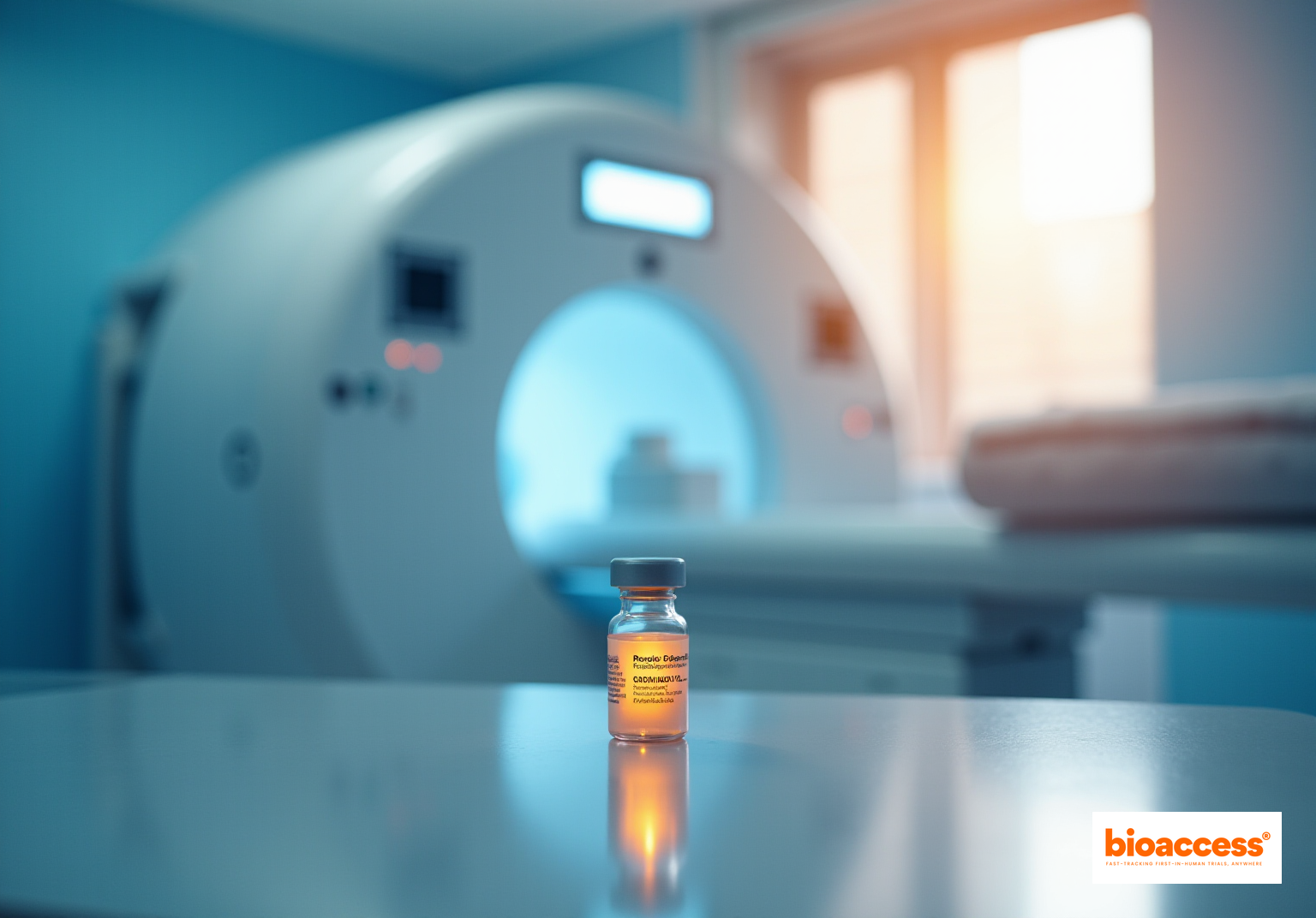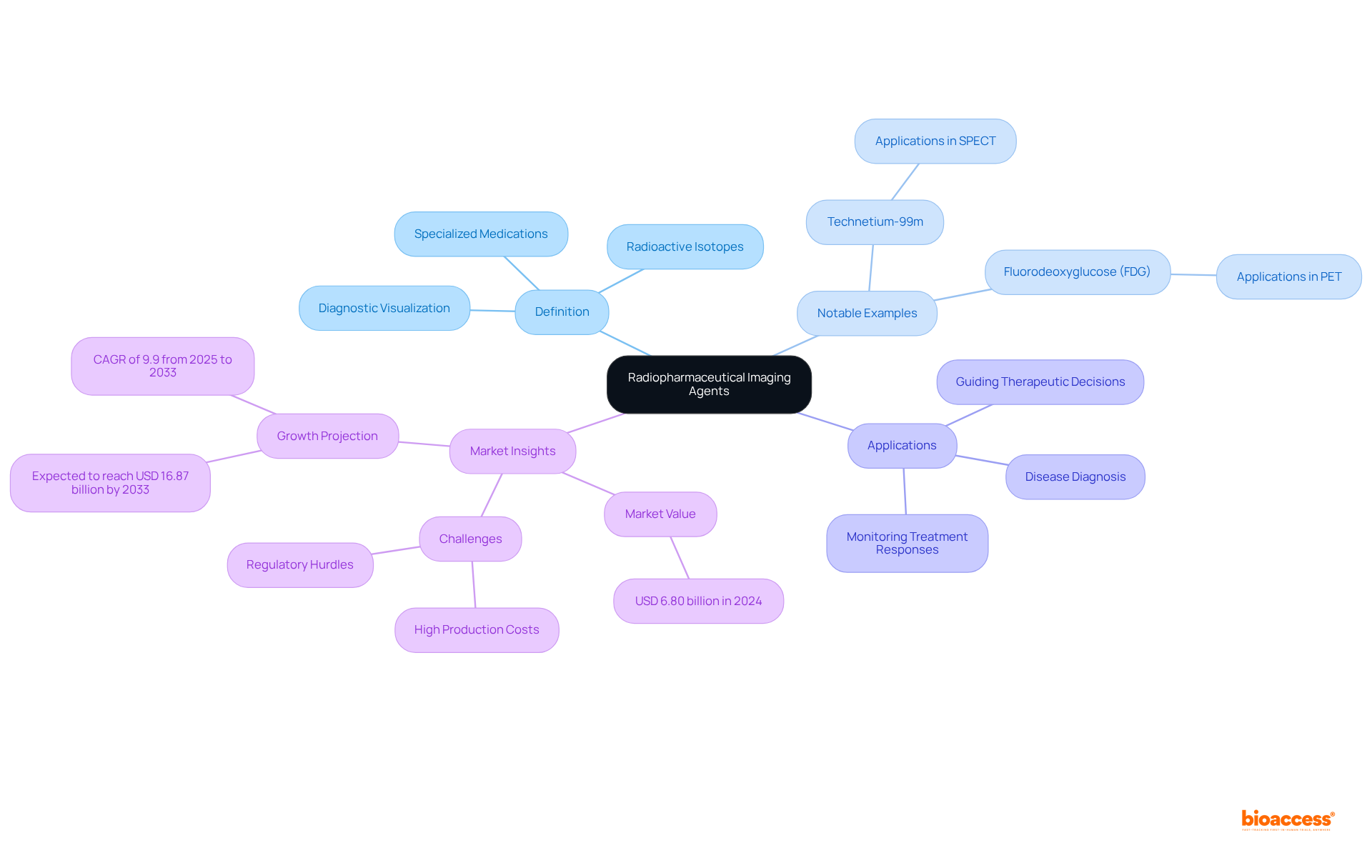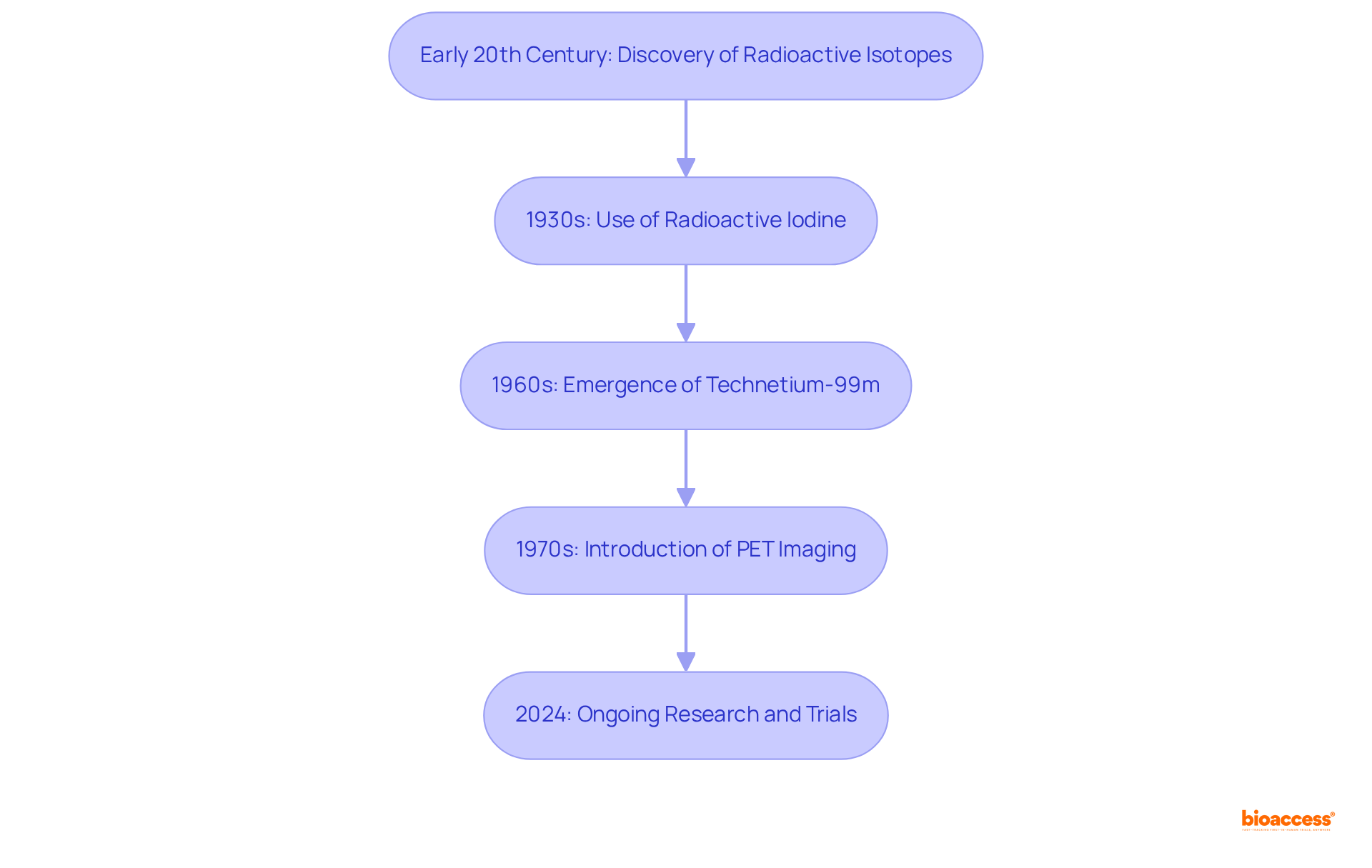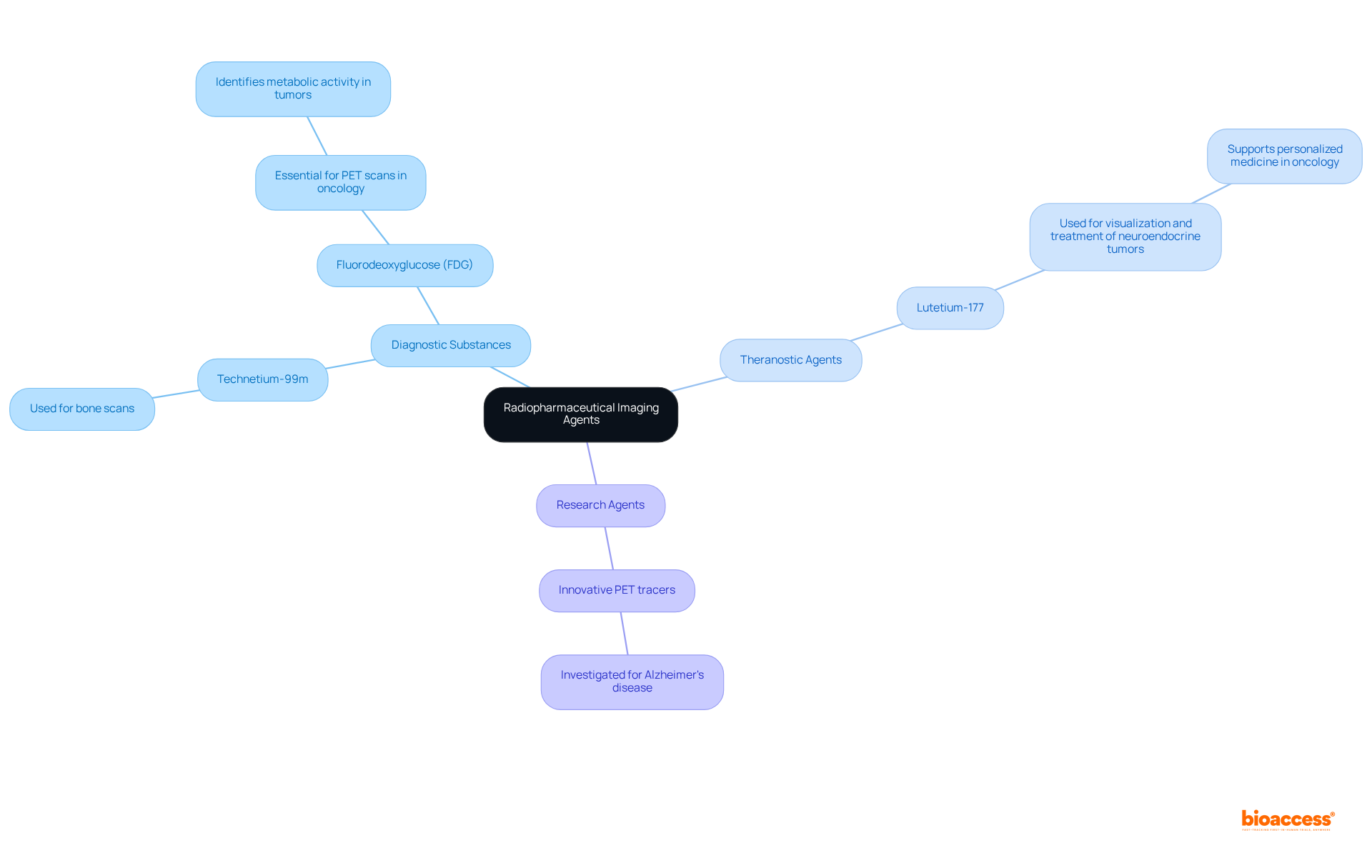


Radiopharmaceutical imaging agents represent a critical category of specialized medications that contain radioactive isotopes, utilized in nuclear medicine for diagnostic visualization. These agents empower healthcare professionals to observe physiological processes and diagnose a range of conditions, with a particular focus on cancer and cardiovascular diseases. Notably, examples such as Technetium-99m and Fluorodeoxyglucose (FDG) underscore their importance in advanced imaging techniques like PET and SPECT. Furthermore, these agents play a pivotal role in enhancing patient outcomes through improved diagnostic capabilities, establishing their indispensable value in contemporary medical practice.
An intricate web of science and medicine, radiopharmaceutical imaging agents represent a groundbreaking fusion of radioactive isotopes and diagnostic imaging technology. These specialized compounds illuminate the inner workings of the human body and hold the key to advancing personalized medicine, ultimately enhancing patient outcomes.
However, as demand for these agents surges amidst rising healthcare challenges, critical questions arise regarding their production, regulation, and the future of nuclear medicine.
What implications does this have for the evolution of diagnostics and treatments in an ever-changing medical landscape?
An overview of radiopharmaceutical imaging agents highlights specialized medications containing radioactive isotopes, which are employed in nuclear medicine for diagnostic visualization. The overview of radiopharmaceutical imaging agents highlights how these substances release radiation recognizable by diagnostic tools, enabling healthcare professionals to observe and evaluate physiological processes within the body. Notable examples include Technetium-99m and Fluorodeoxyglucose (FDG), extensively utilized in imaging modalities such as Positron Emission Tomography (PET) and Single Photon Emission Computed Tomography (SPECT). The radiopharmaceutical imaging agents overview highlights the unique properties of these agents, which allow them to target specific organs or tissues, delivering critical information for diagnosing diseases, monitoring treatment responses, and guiding therapeutic decisions.
The global radiopharmaceutical market was valued at USD 6.80 billion in 2024 and is projected to grow significantly, with a market size expected to reach USD 16.87 billion by 2033, reflecting a compound annual growth rate (CAGR) of 9.9% from 2025 to 2033. This growth is propelled by advancements in molecular visualization and the rising demand for precision medicine. Authorities in nuclear medicine emphasize that the radiopharmaceutical imaging agents overview plays a vital role in identifying and managing various conditions, particularly cancer, cardiovascular ailments, and neurological disorders. As noted by Debashree Bora, "These drugs play a crucial role in diagnosing and treating various conditions, particularly cancer, cardiovascular diseases, and neurological disorders."
Recent research highlights the real-world applications of Technetium-99m, widely used in SPECT scans for various medical conditions due to its optimal half-life and high gamma emission efficiency. Likewise, FDG is crucial in PET scans, especially for cancer detection, as it aids in recognizing metabolic activity in tumors. However, the market for medical isotopes faces challenges, such as high production costs and regulatory hurdles. The incorporation of novel radioactive isotopes continues to improve diagnostic abilities, reinforcing the importance of the radiopharmaceutical imaging agents overview in contemporary healthcare.

The history of radioisotopes is rooted in the early 20th century, marked by the discovery of the first radioactive isotopes. A significant milestone in nuclear medicine occurred in the 1930s with the use of radioactive iodine for thyroid visualization. Over the years, advancements in radiochemistry and visualization technology have resulted in a comprehensive radiopharmaceutical imaging agents overview, showcasing the development of various radioactive pharmaceuticals. Notably, Technetium-99m emerged in the 1960s as a significant example in the radiopharmaceutical imaging agents overview commonly utilized in diagnostic visualization. The introduction of Positron Emission Tomography (PET) imaging in the 1970s contributed to the radiopharmaceutical imaging agents overview, further expanding the applications of radioactive drugs and facilitating more accurate and functional imaging of metabolic processes.
Today, ongoing research is dedicated to innovating and refining medical isotopes, significantly enhancing their efficacy and safety in clinical practice. As of May 30, 2024, there are 1,460 trials involving radioactive drugs, with nearly 28% either planned or ongoing. Dr. Jane Smith, a Nuclear Medicine Specialist, noted, "Radiopharmaceutical therapy has the potential to revolutionize the treatment of cancer and other diseases." The radiopharmaceutical imaging agents overview highlights recent advancements, including the development of new agents that target specific molecular markers, improving precision and reducing radiation exposure to healthy tissues. Furthermore, the potential future applications of radioisotope therapy are expanding, with studies exploring treatments for rare cancers such as pheochromocytoma and paraganglioma. This trajectory of innovation underscores the critical role of the radiopharmaceutical imaging agents overview in modern oncology and diagnostics, highlighting their potential to transform patient care.

An overview of radiopharmaceutical imaging agents emphasizes their crucial role in contemporary medicine, categorized based on their applications and the type of radiation they emit. The primary classifications include:
Diagnostic Substances: Primarily utilized for visualization, these substances enable healthcare professionals to assess various medical conditions. Notable examples include Technetium-99m, widely used for bone scans, and Fluorodeoxyglucose (FDG), essential for PET scans in oncology, which facilitates the identification of metabolic activity in tumors.
Theranostic Agents: These agents serve a dual function, aiding both diagnostic evaluation and therapeutic interventions. Lutetium-177 exemplifies this category, as it is employed for visualization and the treatment of neuroendocrine tumors, highlighting the potential for personalized medicine in oncology.
Research Agents: Employed in clinical trials, these agents are crucial for exploring new imaging techniques or therapeutic applications. For instance, innovative PET tracers are currently being investigated for Alzheimer's disease, underscoring the ongoing advancements in medical imaging agents.
The radiopharmaceutical imaging agents overview highlights the specific indications and protocols for each type of radioactive drug, emphasizing their significance in diagnosing and managing a wide range of medical conditions. The radiopharmaceutical imaging agents overview indicates that as the market for radioactive pharmaceuticals continues to expand, driven by advancements in visualization technologies and the increasing demand for precision medicine, these substances are becoming indispensable tools in clinical practice. Furthermore, with bioaccess®'s expert services—including regulatory approval and participant recruitment—startups in the Medtech, Biopharma, and Radiopharma sectors can accelerate their clinical trials. This ensures quicker regulatory approvals and enhanced participant recruitment, ultimately leading to faster market entry for innovative radiopharmaceuticals.

The radiopharmaceutical imaging agents overview demonstrates how these diagnostic substances play a pivotal role in various clinical applications, significantly influencing individual management and treatment outcomes. In oncology, agents such as FDG are essential for detecting and staging cancers, thereby facilitating personalized treatment strategies. Research has shown that the application of FDG in PET scans leads to a more precise evaluation of tumor metabolism, which is critical for tailoring treatments to meet individual needs. Notably, the reported median overall survival for patients treated with Lu-PSMA-617 is 48.0 months, underscoring the effectiveness of radiopharmaceuticals in enhancing patient outcomes.
In cardiology, Thallium-201 is extensively utilized in myocardial perfusion imaging, providing vital insights into heart function and the detection of coronary artery disease. This agent enables clinicians to visualize blood flow to the heart muscle, allowing for timely interventions. Cardiologists, including Osamu Manabe, emphasize that the accuracy of imaging agents in diagnosing heart issues can significantly improve patient outcomes, as early identification often leads to better management strategies. For instance, advancements in visualization methods have refined the assessment of myocardial perfusion, which is essential for evaluating cardiovascular health.
The radiopharmaceutical imaging agents overview highlights that the impact of radioactive drugs extends beyond mere diagnosis; they are integral in enhancing treatment outcomes and advancing precision medicine. The incorporation of radioactive compounds in treatment planning has been shown to improve therapeutic strategies, particularly in complex scenarios where conventional imaging may fall short. As research continues to evolve, the radiopharmaceutical imaging agents overview highlights the potential for new agents to address unmet medical needs, promising further advancements in patient care across diverse medical fields.

The exploration of radiopharmaceutical imaging agents underscores their fundamental importance in modern diagnostic medicine. These specialized substances, which incorporate radioactive isotopes, not only enhance visualization but also play a crucial role in diagnosing and managing various medical conditions, particularly in oncology, cardiology, and neurology. The advancements in this field highlight the transformative potential of these agents in delivering precise and personalized patient care.
Key insights from this overview illuminate the diverse applications of radiopharmaceuticals, including their classification into:
The historical development of these agents illustrates a trajectory of innovation that has continually improved their efficacy and safety. From Technetium-99m's pivotal role in SPECT scans to the emerging applications of novel isotopes in treating rare cancers, the significance of radiopharmaceuticals in enhancing diagnostic accuracy and treatment outcomes is profound.
As the demand for precision medicine escalates, ongoing research and development of radiopharmaceutical imaging agents promise to address unmet medical needs and foster advancements in patient care. This emphasizes the critical role these agents play not only in diagnostics but also in shaping the future of therapeutic interventions. By embracing the potential of radiopharmaceuticals, we can pave the way for significant improvements in healthcare, underscoring the necessity for continued investment and innovation in this vital area of medicine.
What are radiopharmaceutical imaging agents?
Radiopharmaceutical imaging agents are specialized medications containing radioactive isotopes used in nuclear medicine for diagnostic visualization. They release radiation that can be detected by diagnostic tools, allowing healthcare professionals to observe and evaluate physiological processes in the body.
What are some examples of radiopharmaceutical imaging agents?
Notable examples include Technetium-99m and Fluorodeoxyglucose (FDG), which are extensively utilized in imaging modalities such as Positron Emission Tomography (PET) and Single Photon Emission Computed Tomography (SPECT).
How do radiopharmaceutical imaging agents contribute to medical diagnostics?
These agents have unique properties that enable them to target specific organs or tissues, providing critical information for diagnosing diseases, monitoring treatment responses, and guiding therapeutic decisions.
What is the current market value of radiopharmaceuticals, and what is its projected growth?
The global radiopharmaceutical market was valued at USD 6.80 billion in 2024 and is projected to reach USD 16.87 billion by 2033, reflecting a compound annual growth rate (CAGR) of 9.9% from 2025 to 2033.
What factors are driving the growth of the radiopharmaceutical market?
The growth is propelled by advancements in molecular visualization and the rising demand for precision medicine.
What role do radiopharmaceutical imaging agents play in healthcare?
They are vital in identifying and managing various conditions, particularly cancer, cardiovascular diseases, and neurological disorders.
What is the significance of Technetium-99m and FDG in medical imaging?
Technetium-99m is widely used in SPECT scans due to its optimal half-life and high gamma emission efficiency, while FDG is crucial in PET scans for cancer detection, as it helps recognize metabolic activity in tumors.
What challenges does the market for medical isotopes face?
The market faces challenges such as high production costs and regulatory hurdles, which can impact the availability and development of new radiopharmaceuticals.